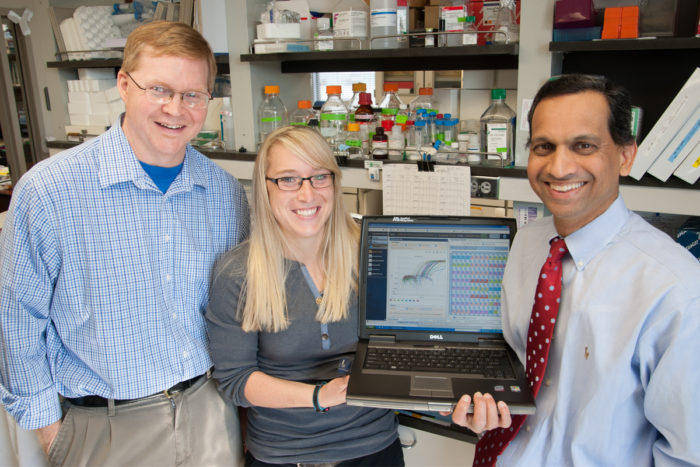Researchers seek method to predict aggressiveness of oral cancer
Studying oral cancer in mice, researchers have found a way to predict the aggressiveness of similar tumors in people, an early step toward a diagnostic test that could guide treatment

Through a study published in Clinical Cancer Research, Ravindra Uppaluri, MD, PhD, (right) led a team that developed a preliminary diagnostic test that identifies aggressive oral tumors. Michael Onken, PhD (left), and Ashley Winkler are co-authors.
Every year approximately 30,000 new cases of oral cancer are diagnosed, and 8,000 people die. In patients with an aggressive form of the disease it is difficult to predict who will respond well to treatment and who will not.
“All patients with advanced head and neck cancer get similar treatments,” said Washington University otolaryngologist Ravindra Uppaluri, MD, PhD. “We have patients who do well on standard combinations of surgery, radiation and chemotherapy, and patients who don’t do so well. We’re interested in finding out why.”
Mouse vs. human
Using a mouse model of oral cancer they developed, the investigators identified a characteristic pattern of gene expression associated with mouse tumors that had spread, or metastasized. They then looked at genetic data from human oral cancer samples and found the same gene expression signature in people with aggressive metastatic tumors.
“We didn’t automatically assume this mouse model would be relevant to human oral cancer,” said Uppaluri, who performs head and neck surgeries at Barnes-Jewish Hospital. “But it turns out to be highly reflective of the disease in people.”
Rather than use genetic methods to induce tumors in the mice, the research team repeatedly applied a known carcinogen, in much the same way humans develop cancer of the mouth.
“Patients often have a history of tobacco and alcohol use, which drive the development of these tumors,” Uppaluri said. “We felt that exposing the mice to a carcinogen would be more likely to produce similar kinds of tumors.”
The researchers, including first author Michael Onken, PhD, Washington University cell biologist, showed that this exposure sometimes produced tumors in the mice that did not spread, but other times resulted in aggressive metastatic tumors, similar to the variety of tumors seen in people.
Powerful collaboration
Uppaluri’s team collaborated with Elaine Mardis, PhD, co-director of Washington University’s Genome Institute, to perform the genomic sequencing and analysis work, comparing their mouse sequences to human data sets from The Cancer Genome Atlas (TCGA), a joint program funded by the National Cancer Institute and the National Human Genome Research Institute. They explored not only gene expression, but also mutation patterns and other genomic issues.
“When we sequenced these tumors, we found that a lot of the genetic mutations present in the mouse tumors also were found in human head and neck cancers,” Uppaluri said.
The analysis identified a common gene expression signature in about 120 genes that was associated with the more aggressive tumors, in both mice and people. They confirmed this finding using data collected from 324 human patients.
Pursuing a clinical test
Using this gene expression signature, the researchers have now developed a proof-of-concept laboratory test to identify those patients who have aggressive tumors. Using oral cancer tumor samples from 33 patients treated at Washington University, they identified aggressive tumors with an accuracy of about 93 percent.
Uppaluri has a patent pending on this technology. He and his team also are studying the genetic signature they found to better understand the biological mechanisms of head and neck cancers. And Uppaluri has recently received additional funding to develop a clinical laboratory test that predicts aggressive disease. Eventually, the goal is to make the test easily available for any patient diagnosed with head and neck cancer.
“These kinds of tests are available for other types of cancer, most notably breast cancer,” he said. “They are transformative genetic tests that can alter the clinical management of patients, tailoring therapies especially for them. It’s our goal to develop something like that for head and neck cancer.”








